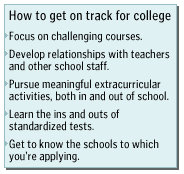
NEW YORK (CNN/Money) -
As if mounting tuition fees weren't bad enough.
College trend trackers say the number of high school graduates seeking a degree has swelled over the past few years – even as admission offices hold the line on enrollment. With competition at an all-time high, the biggest hurdle most young scholars face today is just getting in.
"The number of students applying for college is increasing and projected to increase through the end of this decade," said Barmak Nassirian, executive director of the American Association of Collegiate Registrars and Admissions Offices.
Not only are a larger percentage of high school grads going to college than in years past, but the Echo Boom is coming of age. "The number of 17-, 18- and 19-year-olds in America hit a low in the early 90s and is now on the rebound," he said.
Yet, schools are not raising their enrollment limits, nor are they expected to. "More students are applying for the same number of spaces," said Steven Graff, director of admissions and enrollment services for the College Board.
What's a teen to do?
If you're a student preparing for college, the good news is, there are steps you can take to give yourself an edge.
For starters, keep in mind that the admissions process varies greatly from school to school. At some schools, particularly the larger public universities, applications are sorted in a formulaic fashion. Grades, class rank or standardized test scores may be the only factors under consideration. Other schools, says Graff, use a score-based screening tool to reduce the pool of applicants and then scrutinize each candidate left standing.
| |
 College admissions checklist
College admissions checklist
| |
| | |
| -- Develop relationships with teachers.
|
|
| -- Take part in extracurricular activities, in and out of school.
|
|
| -- Practice for standard tests.
|
|
| -- Spend time writing essays.
|
|
| -- Proofread your application and ask others to do the same.
|
|
| -- Sign up for a challenging course schedule.
|
|
| | |
|
Yet, many colleges see that every application is read front to back at least once by admissions staff who care not just about GPA but the kinds of classes students have been taking, how they spend their time outside of the classroom and what they have to say in their essay. Although this "holistic" approach is more common among smaller private schools, even large universities are starting to base their decisions on more than just report cards.
In other words, getting straight A's and scoring 1,600 on the SATs certainly helps, but it's not everything.
"I'd say academics counts for about two-thirds of the decision at most top schools while the rest counts for about one-third," said Katherine Cohen, who is author of "The Truth About Getting In", a private admissions consultant and former reader (someone who scrutinizes all those applications) for Yale's undergraduate admissions.
"There are lots of kids with high GPAs," said Nassirian. "More colleges are starting to question what else the student brings to the campus."
Stay away from the easy "A"
According to a 2001 survey by the National Association of College Admissions Counselors, the top factor influencing college admissions is grades in college preparatory courses, followed by admission test scores and grades in all subjects.
Click here for CNN/Money's college savings calculator
That said, top schools don't just look at a student's grade point average, they look at whether they've taken difficult classes and have increasingly challenged themselves. In fact, many schools recalculate GPA based on the courses in each transcript.
"If you get straight A's because you didn't take the tough stuff we'll see right away," said Carol Lunkenheimer, dean of undergraduate admissions for Northwestern University.
Learn the fine art of test taking

Standardized tests, such as the SAT or ACT, are the subject of much debate and less important to some schools than they are to others. But there's no avoiding these marathon tests. In fact, more than half of the schools surveyed by the NACAC said these scores weigh heavily on their admission decision.
As a student, your best defense is to find out what tests your dream schools focus on and start preparing for them early on, with the most intense training in the winter of your junior year.
While you certainly will not be able to study for every possible question on these tests, you can learn important tips for taking them. For a price, you can hire a private tutor or enroll in test preparation courses held by Princeton Review and Kaplan. There are also less expensive options, such as one-day seminars, books or computer programs, which can shed light on the process and give you a chance to practice.
Many students choose to take admission tests a couple of times before they feel satisfied with their results. Cohen recommends taking them up to three times, in March and May of your junior year and October of your senior year.
Be a good Samaritan -- and mean it
According to the NACAC survey, work and extracurricular activities is of considerable or moderate importance to half of the schools surveyed and of limited or no importance to the others. Yet, when it comes down to it, many schools – particularly top-tier schools – will look beyond the numbers when deciding between two equally qualified student applicants.
"The personal stuff can make or break your entrance," said Cohen. "Colleges are looking at how you're spending time outside of school. They want to see that you are a productive member of both your school and the community in which you live."

What they don't want to see is a laundry list of activities a student took up during his senior year simply for the sake of getting into college. In fact, the quality of activities is far more important than quantity.
"Colleges place a lot of value on meaningful activities and they look for persistence in such activities," said Nassirian. These activities need not be limited to school; both community service and employment are highly regarded.
How you present these activities in your application is quite important. Rather than just list your extracurricular activities, you should include the years you participated and any relevant information. It's much like a professional resume. "Be as detailed as possible. For example, if they had a job, they should say how much they earned and how they used the money," said Cohen.
If the school doesn't provide adequate space for such accomplishments, feel free to create your own "brag sheet." You can also include samples of your art or writing – within reason.
Show teachers your best side
While you're tackling difficult classes, you'll also want to make a point of developing relationships with your teachers, advisors and coaches. Not only are you likely to learn more, you won't be at a loss when it comes time to get letters of recommendation.
Schools are looking for recommendation letters to give them real insight into a student, not just a generic endorsement. While you might be tempted to ask for endorsements from teachers who gave you perfect scores, you may get better results from someone who worked with you to overcome a difficult subject or a personal challenge.
Express yourself, then proofread
Most kids cringe at the thought of writing a college essay and wait until the last minute to compose this essential part of the application. It's a rough way to spend a Saturday. But it's a great opportunity to make an impression on the admissions board.
"I tell students they should be writing a story that only they can tell in their own words. It should be small in scope but large in the sense that it will communicate their most salient traits," said Cohen.
After you write the essay of your life and finish the application, read everything over several times and then ask the most scrupulous person you know to do the same. After all, it would be a shame to do all of this work only to turn in an application rife with spelling errors or typos.

|

